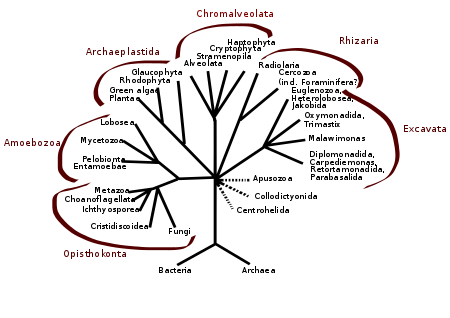From Wikipedia, the free encyclopedia
Taxonomy
 One hypothesis of eukaryote relationships
One hypothesis of eukaryote relationships
One view of the great kingdoms and their stem groups.[1][2][3][4] The Metamonada are hard to place, being sister possibly to Discoba or to Malawimonada[4] or being a paraphyletic group external to all other eukaryotes.[5]
|
|---|
|
|
|
|
|
- Phyla with ≥1000 extant species bolded
- Potentially dubious phyla †
|
|
|---|
|
|
|
|
|
- Phyla with ≥1000 extant species bolded
- Potentially dubious phyla †
|
See also:
|
|
| Phylogeny of the Dikarya and upper-level taxa in Kingdom Fungi.
|
|
|---|
|
|
| | | | | |
|---|
| | Archigregarinorida | |
|---|
| Eugregarinorida | | Aseptatorina | |
|---|
| Blastogregarinorina | |
|---|
| Septatorina |
- Fusionicae (Fusionidae)
- Gregarinicae (Cephaloidophoridae, Cephalolobidae, Didymophoridae, Gregarinidae, Hirmocystidae, Metameridae, Uradiophoridae)
- Porosporicae (Porosporidae)
- Stenophoricae (Acutidae, Amphiplatysporidae, Brustiophoridae, Cnemidosporidae, Dactylophoridae, Leidyanidae, Monoductidae, Monoicidae, Sphaerocystidae, Stenophoridae, Trichorhynchidae)
- Stylocephaloidea (Actinocephalidae, Stylocephalidae)
- Blabericolidae
|
|---|
|
|---|
| Neogregarinorida | |
|---|
|
|---|
|
|---|
|
|---|
|
|
|---|
- ^ Brown MW, Heiss AA, Kamikawa R, Inagaki Y, Yabuki A, Tice AK, Shiratori T, Ishida KI, Hashimoto T, Simpson A, Roger A (2018-01-19). "Phylogenomics Places Orphan Protistan Lineages in a Novel Eukaryotic Super-Group". Genome Biology and Evolution. 10 (2): 427–433. doi:10.1093/gbe/evy014. PMC 5793813. PMID 29360967.
- ^ Schön ME, Zlatogursky VV, Singh RP, et al. (2021). "Picozoa are archaeplastids without plastid". Nature Communications. 12 (1): 6651. bioRxiv 10.1101/2021.04.14.439778. doi:10.1038/s41467-021-26918-0. PMC 8599508. PMID 34789758. S2CID 233328713.
- ^ Tikhonenkov DV, Mikhailov KV, Gawryluk RM, et al. (December 2022). "Microbial predators form a new supergroup of eukaryotes". Nature. 612 (7941): 714–719. doi:10.1038/s41586-022-05511-5. PMID 36477531. S2CID 254436650.
- ^ a b Burki F, Roger AJ, Brown MW, Simpson AG (2020). "The New Tree of Eukaryotes". Trends in Ecology & Evolution. 35 (1). Elsevier BV: 43–55. doi:10.1016/j.tree.2019.08.008. ISSN 0169-5347. PMID 31606140. S2CID 204545629.
- ^ Al Jewari, Caesar; Baldauf, Sandra L. (28 April 2023). "An excavate root for the eukaryote tree of life". Science Advances. 9 (17): eade4973. Bibcode:2023SciA....9E4973A. doi:10.1126/sciadv.ade4973. ISSN 2375-2548. PMC 10146883. PMID 37115919.




